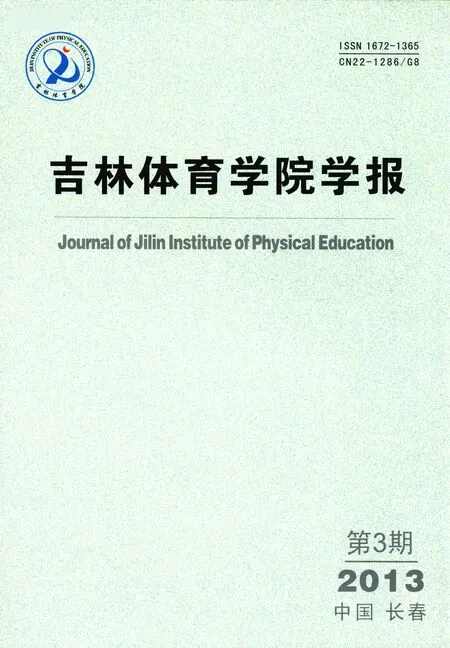肌肉力量训练神经适应机制研究综述
梁成军
(辽宁师范大学 体育学院,辽宁 大连 116029)
肌肉力量训练神经适应机制研究综述
梁成军
(辽宁师范大学 体育学院,辽宁 大连 116029)
力量训练引起的肌力增加,神经系统起着重要作用,是力量训练研究领域的一个热点问题。主要从运动单位募集、放电、协调与同步,力量训练中枢适应等方面对肌肉力量训练的神经适应特征与机制方面的研究进行分析与讨论,旨在阐明其研究的现状。运动单位募集遵循尺寸原则,不同收缩方式募集控制策略不同;运动单位放电率的变化对肌肉力量产生影响,但也存在不同的观点。运动单位同步与肌力的关系尚不明确,力量训练可以产生中枢神经系统的适应性变化,由于技术与方法的限制,这方面的一些问题仍需进一步探索。
肌肉;力量训练;募集;放电率;神经适应
肌肉力量的大小与增长不仅取决于肌肉的体积,也取决于神经系统合理动员肌肉的能力。在力量训练的初期或训练动作发生改变时,神经系统会发生适应性的改变,以完成对肌肉的最佳控制。此时肌肉力量的增长主要是由于神经系统适应性变化引起的。如对侧肢体的力量训练效应就是一个实例。尽管大多数研究不能解释这种效应是真实的转换还是动作熟悉所致。然而,Timothy[1]妥善控制的研究表明,对侧的力量训练效果力量增加的大小是初始力量的8%或训练一侧的一半左右。这可能反映的是运动神经元输出,而不是增加肌肉的适应。于俊海[2]研究结果也支持同样的结论,同时认为训练导致的力量增长与肌肉动员能力的增长有关。越来越多的研究表明神经系统在肌肉力量训练起十分重要的作用。这方面的研究对于运动训练和康复医学意义明显。基于此,本文对近年来肌肉力量训练神经适应方面的研究成果进行了梳理。
1 运动单位募集
神经系统通过改变激活运动单位的数量或改变运动单位激活程度来调节肌肉产生的力量大小[3]。尽管力量训练的神经适应机制扮演重要角色,但目前对这些机制如运动单位募集方式的细微变化和神经驱动的增加等方面的认识进展缓慢。研究已表明在等长或动力训练后,在连续递增负荷收缩中运动单位的募集仍然遵循尺寸原则[4],即运动单位较低阈值最先被动员,产生力量较低;高阈值较晚被动员,收缩力量较大。用30%-40%最大负荷对胫骨前肌进行12周动态阻力训练,运动单位募集次序也没有发生变化[5]。然而,目前还不清楚训练对运动单位募集上限的影响。有研究已观察到老年人运动单位募集阈值降低,以20%最大力量收缩时,老年人平均动员70%,年轻人动员40%,而肌肉力矩没有显著差异,表明老年人靠动员阈值降低引起的动员数目增加所致[6],结果导致肌肉的力量能力主要依靠放电频率[7]。依据现有研究,还不能确定训练是否会扩大运动单位募集的范围,从而改变运动单位募集和放电率对肌肉在运动范围内的力量大小。
离心收缩和向心收缩在运动单位募集和放电频率的调节上是不同的[8]。Julien[9]研究认为离心最大随意收缩(MVC)是在脊髓或其以上中心水平进行调制的。虽然向心和离心收缩时肌肉的性能不同,这些差异在功能任务的实现,取决于从脊髓发出的激活信号的特点[10],即是控制策略的不同。运动单位的激活依赖于执行任务的性质,如Elizabeth[11]比较向心和离心等速训练对股四头肌肌力、截面积和神经激活的影响。认为向心和离心训练的结果高度依赖用于训练和测试的肌肉动作。有研究证实训练诱发的自主激活在向心和离心收缩中均显着改善,随意力量的增强部分归因于离心训练诱导自主激活的增加[12]。
2 运动单位放电率
运动单位放电频率可以对肌肉力量的变化产生影响。近期研究表明[13],手部肌肉力量变化与运动单位放电率的变化和调制有关;等长收缩时,运动单位放电率低频的变化,可以解释大部分运动单位收缩力的变化。因此放电率的改变是肌肉等长收缩力量发生变化的主要因素[14]。运动单位在高力量收缩放电率发生在运动单位力量、放电频率关系的上部区域,而不是平台期[15]。因此,在快速自主收缩期间,肌肉产生的MVC力量小于最大强直收缩的力量。在递增负荷的收缩中,放电率也从最小值逐步增加到最大值[16]。这些观察说明MVC力量和其最大的发展速率低于肌肉的固有能力,因此也能通过增加肌肉的放电频率来提高。阻力训练早期,力量增长显著,最大运动单位放电率的增加是重要的神经适应机制[17]。与这种期望一致,训练引起的放电率的变化已经在肌肉进行最大自主收缩[18]和快速收缩[19]中观察到。
然而,Pucci[20]研究表明等长抗阻力量训练增加了肌肉运动单位的自主激活数目,但是测量的多运动单位放电率却没有变化,认为可能是肌肉力量的变化是由于运动单位的募集变化的结果。对手指的力量训练[21]数据也证实训练可使运动单位放电率的可变性降低,从而使手指更灵活。
3 运动单位的同步与协调
依据运动单位动作电位放电特性可以判断肌肉收缩时运动单位同步与协调情况。有研究认为运动单位高频同步通过皮层脊髓回路进行调解,低频同步则通过外周传入神经通路进行调解[22]。Semmler[23]的研究推测运动单位同步的作用是增加力量的发展速率或者是作为一种机制在肌肉快速收缩中协调多个肌肉的活动。其后继的实验数据[24]表明力量训练后运动单位同步与力量增长并无显著关联,提示运动单位同步在肌肉的力量表达中并不十分重要。短期的负重抗阻训练引起骨骼肌的神经活动发生适应,产生最大力量增加的效果,表现为在训练后克服最大阻力时主动肌表面肌电振幅的积分均值有所降低,在不同训练经历的受试者之间有相似倾向[25],提示短期抗阻训练后最大力量增加的神经适应主要方式可能并非仅是运动单位募集数量的增加,亦可能是各运动单位之间的活动更为精确协同。上述阐述可以看出,运动单位协调与同步与肌肉力量表现的关系的看法还不一致。另外,单一的离心收缩力量训练后,肌肉运动单位的同步性增强,其机制尚不明确[26]。
4 力量训练的中枢适应
虽然长期以来人们考虑阻力训练会使中枢神经系统产生适应性变化,该观点还没有形成一个统一的认识。Selvanayagam[27]研究了颅磁刺激(TMS)诱导肌肉颤搐的转变,探讨等长肌力与各种收缩的持续时间和速度力量发展特点。研究认为力量训练早期有着类似运动学习皮质变化的神经反应。一些研究也表明短期的运动技术训练,扩大了皮层的肌肉代表区域,增加了皮层脊髓通路的兴奋性[28],可能归因于皮层内部抑制的选择变化[29]。
尽管运动技术训练能够增加皮层脊髓的兴奋性,但力量训练似乎没有伴随这种类似的适应。例如,Jensen[30]发现,每周3次技术训练,进行4周,TMS诱导的最大运动诱发电位增加,而在休息时和收缩时引起运动诱发电位需要的最小刺激强度降低。此外,Carroll[31]发现对手部肌肉进行4周力量训练,其最大等长收缩力矩增加,对于特定的肌肉活动水平,阻力训练后TMS和TES(颅电刺激)诱发的肌电幅值减小,TES诱发动作电位的潜伏期比TMS短。这些结果说明力量训练改变了脊髓回路功能特征,而不是运动皮层的输出。
训练导致的神经元之间联系的改变,可以通过反射来证明。H反射可用于评估脊髓α运动神经元的兴奋性,同时也反映了在IA类传入突触的传输效率。V型波反映因中央通路降活化而导致的α运动神经元池传出运动单位输出的总体规模。在人体中脊髓范围内的训练适应常通过电诱发反射来进行评估。一些研究表明力量训练增加了H波和V波的振幅[32],揭示力量训练诱导的运动神经元输出增加是脊髓及以上中枢适应的机制。力量训练后V波与最大M波比率(V/Mmax)显著增加,但最大的H波与M波比率(Hmax/Mmax)保持不变[33];同时训练引起了H反射兴奋阈值显著下降,而H反射的升支振幅保持不变。这些观察表明,MVC力量的训练提高,有可能归因于神经降级驱动和传入调控的增加。但有研究认为负重超等长训练可使Hmax/Mmax幅度降低[34],影响α运动神经元终池兴奋性,增加突触前抑制的作用,降低运动中枢的抑制作用,增加肌肉张力。
总之,对于力量训练的神经中枢适应问题,现有研究多数依据反射和运动诱发电位等评估手段来间接探讨其可能产生的适应特征与机制,研究的结果目前还不能详实揭示力量训练的中枢适应机制。
5 结语
综上,根据目前的研究,阻力训练伴随着力量发展中发挥重要作用的中枢神经系统的变化。神经系统的许多方面表现出阻力训练适应的特征。然而,阻力训练后的神经适应的证据仍然是间接的,其机制尚不完全清楚。测试技术的限制使多数研究认识有限,也限制了目前对神经适应机制的研究范围。一些问题如运动单位如何完成放电的改变而产生自主激活的增加,神经适应与运动单位活动变化之间的关联,运动单位活动与肌肉功能之间的关系等仍需进一步研究探讨。
[1] Carroll, Timothy J., Robert D. Herbert, Joanne Munn, et al. Contralateral effects of unilateral strength training: evidence and possible mechanisms[J]. J Appl Physiol. 2006,101: 1514-1522.
[2] 于俊海,周石,黄力平,等. 单侧肢体电刺激或随意力量训练对双侧足背屈力量和肌肉动员能力的影响[J].中国康复医学杂志, 2008,23(9):777-781.
[3] [美]扎齐奥尔斯基.运动生物力学—运动成绩的提高与运动损伤的预防[M].陆爱云译.北京:人民体育出版社.2004.
[4] Andrew J. Fuglevand. Mechanical properties and neural control of human1 hand motor units[J]. J Physiol 2011,589(23):5595-5602.
[5] Van Cutsem M, Duchateau J, and Hainaut K. Changes in single motor unit behaviour contribute to the increase in contraction speed after dynamic training in humans[J]. J Physiol 1998,513:295-305.
[6] Klass M, Baudry S, and Duchateau J. Contractile properties of single motor units in elderly[J]. Comp Meth Biomech Biomed Eng. 2005,8(1):167-168.
[7] Connelly DM, Rice CL, Roos MR, and Vandervoort AA. Motor unit firing rates and contractile properties in tibialis anterior of young and old men[J]. J Appl Physiol 1999,87: 843-852.
[8] A Kossev, P Christova. Discharge pattern of human motor units during dynamic concentric and eccentric contractions.1998,109(3):245-255.
[9] Duclay, Julien and Alain Martin. Evoked H-reflex and V-wave responses during maximal isometric, concentric, and eccentric muscle contraction[J]. J Neurophysiol,2005,(94): 3555-3562.
[10] Jacques Duchateau and Roger M. Enoka.Neural control of shortening and lengthening contractions: influence of task constraints[J]. J Physiol 2008,586(24):5853-5864.
[11] Higbie, Elizabeth J., Kirk J. Cureton, Gordon L. Warren III, et al. Effects of concentric and eccentric training on muscle strength, cross-sectional area, and neural activation[J]. J. Appl. Physiol. 1996, 81(5): 2173-2181.
[12] Nordlund Ekblom MM. Improvements in dynamic plantar flexor strength after resistance training are associated with increased voluntary activation and V-to-M ratio[J]. J Appl Physiol.2010,109:19-26.
[13] Francesco Negro, Ales Holobar, Dario Farina. Fluctuations in isometric muscle force can be described by one linear projection of low-frequency components of motor unit discharge rates[J]. J Physiol.2009,587(24):5925-5938.
[14] Moritz, Chet T., Benjamin K. Barry, Michael A. Pascoe, and Roger M. Enoka. Discharge rate variability influences the variation in force fluctuations across the working range of a hand muscle[J]. J Neurophysiol 2005,93:2449-2459.
[15] Macefield VG, Fuglevand AJ, and Bigland-Ritchie B. Contractile properties of single motor units in human toe extensors assessed by intraneural motor axon stimulation[J]. J Neurophysiol.1996,75:2509-2519.
[16] Dario Farina and Deborah Falla. Discharge Rate of Sternohyoid Motor Units Activated With Surface EMG Feedback[J]. J Neurophysiol.2009,101:624-632.
[17] Gary Kamen and Christopher A. Knight. Training-Related Adaptations in Motor Unit Discharge Rate in Young and Older Adults[J]. Journal of Gerontology: MEDICAL SCIENCES. 2004,59(12):1334-1338.
[18] Kamen G and Knight CA. Training-related adaptations in motor unit discharge rate in young and older adults[J]. J Gerontol A Biol Sci Med Sci.2004,59:1334-1338.
[19] Van Cutsem M, Duchateau J, and Hainaut K. Changes in single motor unit behaviour contribute to the increase in contraction speed after dynamic training in humans[J]. J Physiol.1998,513:295-305.
[20] Pucci AR, Griffin L, and Cafarelli E. Maximal motor unit firing rates during isometric resistance training in men[J]. Exp Physiol.2005,91:171-178.
[21] Kornatz, Kurt W., Evangelos A. Christou, and Roger M. Enoka. Practice reduces motor unit discharge variability in a hand muscle and improves manual dexterity in old adults[J]. J Appl Physiol 2005,98:2072-2080.
[22] Farmer SF, Bremner FD, Halliday DM, Rosenberg JR, and Stephens JA. The frequency content of common synaptic inputs to motoneurones studied during voluntary isometric contraction in man[J]. J Physiol.1993,470:127-155.
[23] Semmler JG. Motor unit synchronization and neuromuscular performance[J]. Exerc Sport Sci Rev.2002,30: 8-14.
[24] Semmler JG, Sale MV, and Kidgell DJ. Motor unit synchronization measured by cross-correlation is not increased with strength training of a hand muscle[J]. Proc Int Australas Winter Conf Brain Res.2006,24:2-5.
[25] 段子才,陈佩杰. 不同训练经历者六周负重蹲起训练后股四头肌和腘绳肌最大用力时表面肌电振幅变化的对比研究[J]. 中国运动医学杂志. 2009,28(3):251-254.
[26] Dartnall TJ, Nordstrom MA, Semmler JG. Motor unit synchronization is increased in biceps brachii after exercise-induced damage to elbow flexor muscles[J]. J Neurophysiol.2008,99:1008-1019.
[27] Victor S. Selvanayagam, Stephan Riek,Timothy J. Carroll.Early neural responses to strength training[J]. Journal of Applied Physiology.2011,111(2):367-375.
[28] Classen J, Liepert J, Wise SP, Hallet M, and Cohen LG. Rapid plasticity of human cortical movement representation induced by practice[J]. J Neurophysiol.1998,79: 1117-1123.
[29] Liepert J, Classen J, Cohen LG, and Hallett M. Task-dependent changes of intracortical inhibition[J]. Exp Brain Res.1998,118:421-426.
[30] Jesper Lundbye Jensen, Peter C. D. Marstrand, and Jens B. Nielsen.Motor skill training and strength training are associated with different plastic changes in the central nervous system[J]. J Appl Physiol 2005,99:1558-1568.
[31] Carroll TJ, Riek S, and Carson RG. The sites of neural adaptation induced by resistance training in humans[J]. J Physiol.2002,544:641-652.
[32] Aagaard, Per, Erik B. Simonsen, Jesper L. Andersen, Peter Magnusson, and Poul Dyhre-Poulsen. Neural adaptation to resistance training: changes in evoked V-wave and H-reflex responses[J]. J Appl Physiol,2002,92: 2309-2318.
[33] Carolina Vila-Ch?, Deborah Falla, Miguel Velhote Correia, and Dario Farina. Changes in H reflex and V wave following short-term endurance and strength training[J]. Journal of Applied Physiology.2012,112(1):54-63.
[34] 田石榴. 负重超等长力量训练的神经肌肉适应机制研究[D].上海:上海体育学院,2009.
TheSummaryoftheResearchonNeuralAdaptationMechanismofMuscleStrengthTraining
Liang Chengjun
(School of Physical Education,Liaoning Normal University,Dalian, 116029,Liaoning,China)
The increasing muscle strength caused by strength training, which the neural system plays an important role, has become a focus in the research field of strength training. The author summarized research results on the character and mechanism of neural adaptation in muscle strength training, which is mainly from the aspects of motor recruitment, discharge rate, synchronization and neural center adaptation and so on. The major idea is to elucidate its present research situation. Size Principle was followed in motor recruitment, and the control strategies of different contraction form are different. The change of discharge rate of motor unit has effect on muscle strength, but with different opinion. The relationship between motor synchronization and muscle strength is not clear. Adaptation change caused by muscle strength training in central nervous system, and some issues needed to be further study because of restriction on research technique and method.
muscle;strength training;recruitment;discharge rate;neural adaptation
2012-11-26;
2012-12-29
梁成军(1970-),男,博士,讲师,研究方向:运动训练学、体育工程。
G808.14
A
1672-1365(2013)03-0014-04

